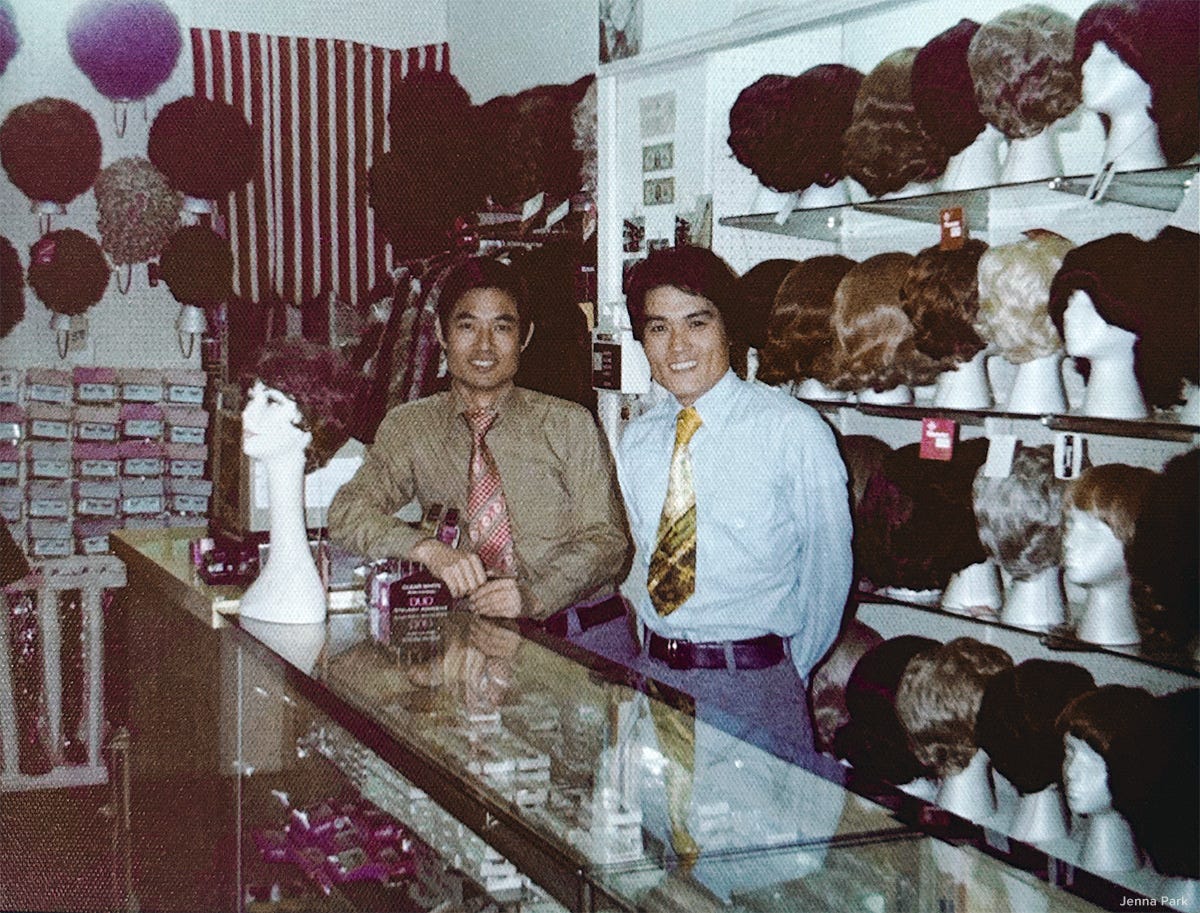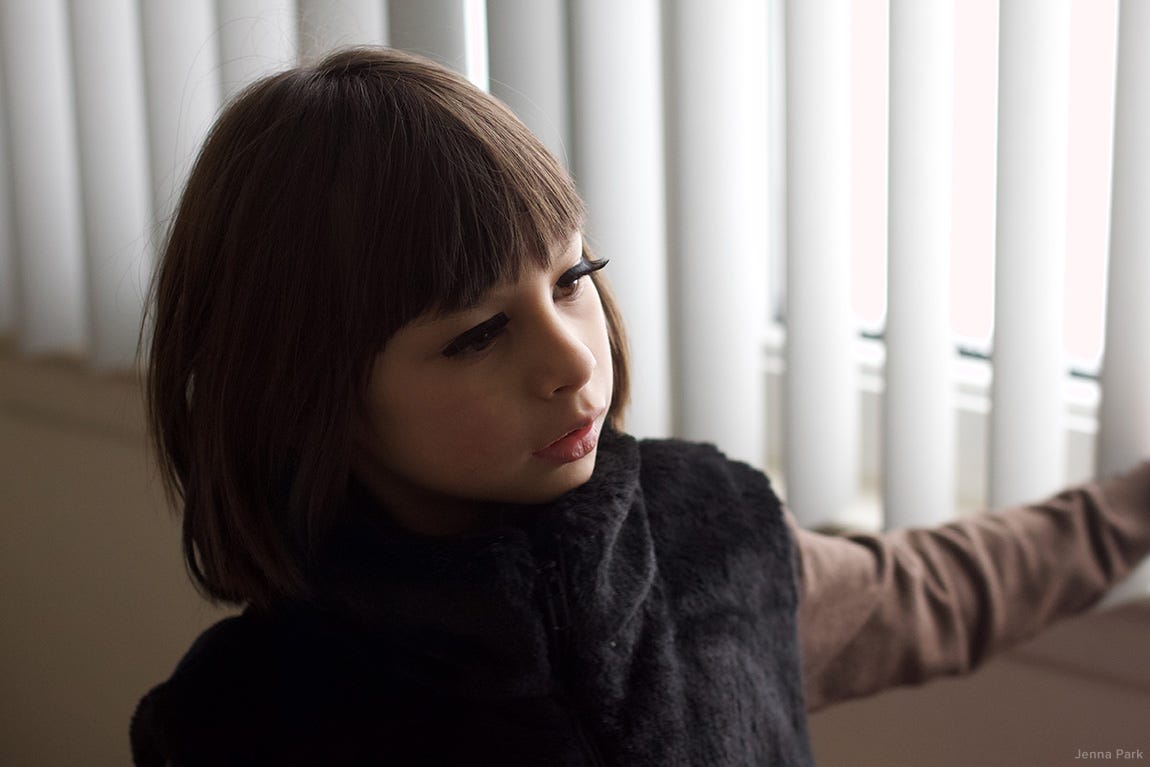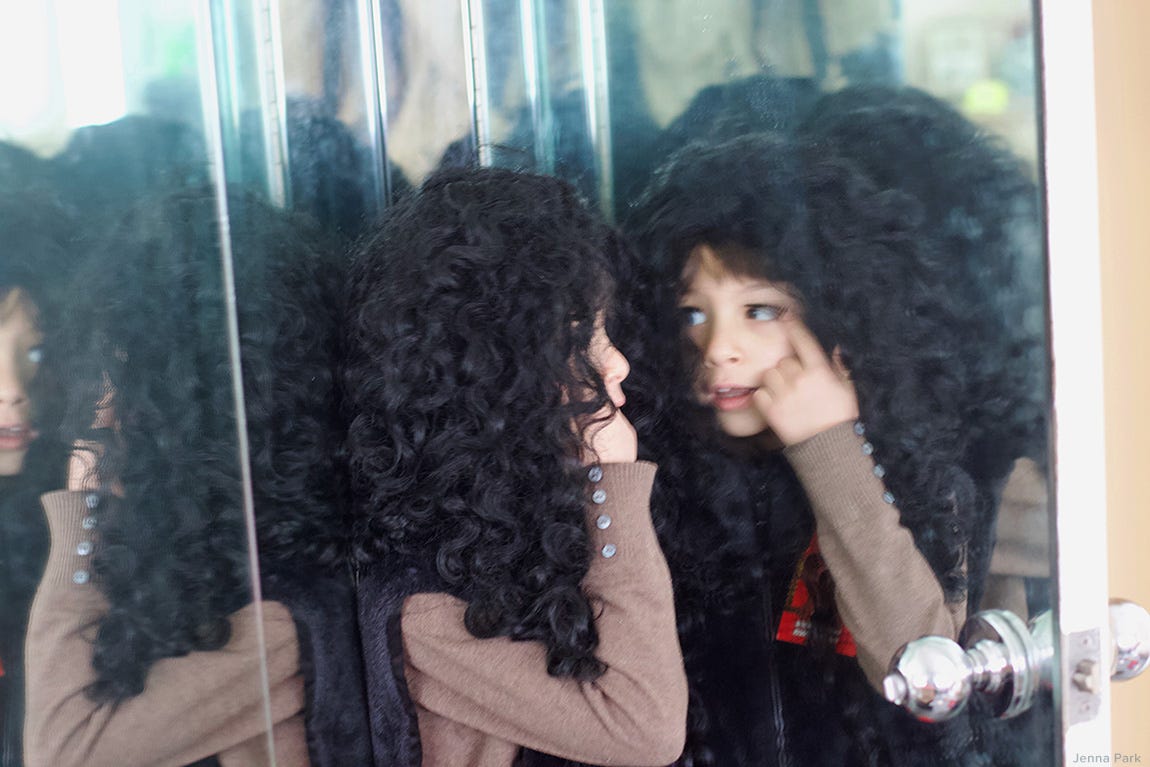On this Father's Day, a story about wigs, a story about New York
And an excerpt from a short interview with my dad, wig seller to the stars.
Childhood memories of wigs
I grew up around wigs. Lots of them. Growing up in our house meant that at any given time a wig or two might be hanging from our shower faucet handles, hung to dry after being hand washed. Sometimes as a kid I would lock the bathroom door behind me and try them on, like I would see the fancy ladies do at my dad’s store. A rotating cast of wigs would be brought home to get washed, but my favorites were the long, caramel-colored ones with the cascade of curls that tumbled down like wild waves from the crown. I always wondered if real people had hair like this. I imagined that if they did, they would be princesses or at the very least, people with important jobs.
My dad’s wig store was on 58th Street between Park and Lex in midtown Manhattan, once known for being a hub for wigs and hair. The store wasn’t big; it was a long galley of a space with just enough room for an eight foot glass counter of hair products, accessories, and the really special hair pieces made from 100% human hair that came packaged in cellophane. A small bamboo shade separated the front from the back of the store where a small lighted vanity sat against the wall. My dad would lower the shade down for privacy from the street-facing glass storefront whenever he had customers sit down to try on new looks.
Opposite the glass counter was a peg wall filled with rows and rows of pastel cases of closed eyelids looking demurely down, lashes attached to the bottoms like pretty trimmings on the hem of a dress. There must have been hundreds of them. I loved studying all the different styles, my eyes darting at each plastic case trying to spot the differences between the ones that were too subtle at first glance to tell apart. It was like playing a memory game. The really long lashes that looked like leggy spider legs were the ones that kind of scared me, but I vowed to sneak some of my favorites home one day to glue them onto my own eyelids because I wasn’t born blessed with anything that you could really call lashes.
The rest of my dad’s store was covered with wigs, filling up every inch of wall space possible. Some sat on shelves atop styrofoam heads, and some hung on the walls from hooks to showcase the styles from the back. The wigs in his ceiling-to-floor storefront window were showcased by the fanciest mannequin heads of all—the ones in matte antique gold with painted faces and elongated necks like giraffes that spun around on very slow, multi-level rotating displays. I loved studying all the different cuts and colors, making mental notes of all the names.
The Pageboy
Ms. Casual
Tigress
The London Shag
The Freedom Wig
The Farrah

Walking into my dad’s wig store was like being hit with a cacophony of colors and textures. You never truly understand how many different colors hair could be until you see them in isolation all lined up in rows, not attached to limbs or torsos, not distracted by patterns or clothing. Chestnut, sable, ash. All names of colors I had never heard of before. My favorite thing to play with when I visited his store was the color swatches—a keyring filled with three or four dozen fluffy hair tails with numeric codes that identified your shade of hair color. The swatch rings were large and heavy. I loved brushing the hair and fanning them out. I loved holding the swatches up to my own hair to find the exact numerical shade. I was surprised to discover that my hair wasn’t black, not even close.
Diana days were the best days
Every morning my dad would drive from our house in Queens to a parking garage in Flushing, where he would catch the 7 train to Queensboro Plaza and transfer to the N to cross the river one stop into Manhattan. He would get off at 59th and Lex and walk the three blocks to his store to open the doors at 10am sharp.
For 27 years, six days a week, my dad would walk through the heavy glass doors of his shop every morning and start his day with a routine like Mr. Rogers. He would take off his black dress shoes, fold his pant cuffs once, and put on his slippers. Next came his jacket, which he would trade for a gray fleece vest or a cardigan. Then he would open his pile of daily newspapers—The NY Daily News, The Korea Times—and read the paper until customers came in.
The wig business wasn't exactly a lucrative business even at the height of its popularity in the 70s, but my dad did have a few high profile celebrity clients that made the stories that I told as an adult a unique one that nobody else could tell. Who else had a dad who owned a wig store? Not anyone else I’ve ever met. But when I was a kid, I dreaded with a passion the day that we would have to go around and talk about what our parents did for jobs. It embarrassed me to reveal that my dad sold wigs when it was my turn. Why couldn’t my dad have a normal job like a plumber, or a lawyer, or an accountant like all the other kids? It wasn’t until maybe high school when I showed my friends autographed photos of Cyndi Lauper and Janet Jackson that my dad brought home that I started to feel the grips of embarrassment lessen.
But Diana days were the best. Those were the days my dad would excitedly come home from work waving a check in his hand to show us that Diana Ross had made an order that day. One single order from her would meet his sales quota for that month in multiples. I’m assuming that my dad wasn’t Ms. Ross’ exclusive wig dealer, but she was a repeat loyal customer who would call on him as recently as 2018, long after he closed his shop down in 2002 after 27 years. He was still doing phone orders for his most valued customers—mostly for lashes at that point—but by 2018, the evidence of his Alzheimers was clear and he had winded his business down. When he saw Diana on TV at the Macys Thanksgiving Parade later that month—the event that she needed the wigs for—he critiqued the hair saying that it wasn’t as good as his wigs would have been.
My dad’s store as the backdrop of my youth
Most of my memories of my dad’s store came during my late teens and twenties. It’s only now, with distance, that I realize his store features in so many milestones of my young adult life. When I was going to college at The Cooper Union downtown, I would ride the 6 train from the East Village up to his store to catch a ride home for the weekend. But sometimes I would just visit him at his store and we would eat lunch together. Just like his morning routine, my dad would order the same things for lunch nearly every day, alternating between a slice of pizza and Chinese food. We’d share a container of hot and sour soup and he’d get shrimp lo mein and I’d order sesame noodles. We never talked much, but sat together, him at the end of the glass counter, me at the vanity, and we’d eat our lunch in silence. Sometimes I’d join in and read the paper too, or we’d talk about sports or the weather. I’d then take the 6 train back to Astor Place, back to my life, my friends, my downtown world.
When I decided to quit art school after my junior year, my dad’s store was my last stop in NYC before I got in a car and drove away to travel the country. It was the first time I saw tears in his eyes as he waved at me from the street in front of his store. It was at that moment that I promised him I would eventually go back to school. I remember turning back often to look back at him as I walked east on 58th, his body getting smaller and smaller in the distance until he was no longer there on the horizon.
When you’re that young with the entire world in front of you, the feelings of your parents don’t come into play with life decisions all that much. Maybe by nature, teens are meant to be self absorbed in order to break free and become independent. I was moved by his tears then, but can only see now how difficult if must have been, in an age without cell phones or the internet, to let your child go without any idea of when they would return. As it turned out, I would be gone for eight months, only to come back to pack my things and move out to Washington State to finish school as I had promised.
Years later when I moved back home from Portland, OR in the late 90s, I briefly lived with my parents again and my father’s daily commute on the 7 to the N became mine too. I had secured my first design job at a beauty company just two blocks away from his store on 56th street and we would commute together every morning and evening. We did this for 8 months until I earned enough money to move back to Manhattan. Sometimes during our 7 train commute, I would sit opposite him on the subway and would look at him like a stranger might, without all that baggage, without all that history, and I would just see a middle-aged man, eyes intently fixed on his folded newspapers to avoid eye contact with other commuters. He was the same age then as I am now.
When I graduated from grad school from NYU Tisch at Carnegie Hall in 2000, we used my dad’s store as home base to gather family since it was nearby. It was only a few weeks after that he would get the notice that his lease wouldn’t be renewed in two years. I remember my last trip to his store as an attempt to “interview” him for an issue on hair that I was publishing for my Asian American webzine that I ran for three years with some friends back in the early 2000s.1
A day in the life of a wig seller
I luck out on the day I go visit because as I walk in, he’s about to close on a wig sale to a customer.
“Looks good. Very natural. No one can tell,” he says as he brushes and trims the wig for a woman who I guess was in her late 30’s.
The woman turns her head from side to side, pausing as she looks thoughtfully at her reflection. He continues brushing and showing her different ways to style the hair.
“No one knows it’s a wig,” he assures her again.
She spends a few more minutes twisting and turning her head, staring at her reflection in deliberation. Finally, she is satisfied.
“Wash every 2 weeks. Warm water. Baby shampoo. Hang dry,” he instructs.
The woman makes the purchase and wears her new wig out the store.
I always found it amusing to watch him work because it was like watching a different person who wasn’t my dad. To hear him talk about wigs and hairstyles to his customers, was a side of him that you would never have guessed if you observed him at home. My dad did not look like a man who primped the hair of customers from all walks of NYC life who came through the doors of his store: cancer patients, stylists and entertainers, hair and makeup people working in theater and Broadway, women who just wanted to change their looks, women whose religions required them to cover their hair, the occasional balding man, the Halloween costume seeker, and yes…drag queens.
—
The Interview
So here’s my attempt to interview my dad. I know I’m going to get one word answers and he barely looks up at me from the newspaper he’s reading, but what the hell.
Me: So, dad. Why did you decide to open a wig store when you came to America
Dad: What do you mean why?
Me: I mean, why wigs?
Dad: That’s what people did back then. Very popular business.
Me: But why was it popular with Korean immigrants?
Dad: What do you mean why?
Me: Uh, do you like selling wigs?
Dad: It’s okay.
Me: What are you going to do when you have to close the store?
Dad: I dunno yet.
Me: What are you going to do with all these wigs?
Dad: Big sale. Sell everything! All must go.
Me: Um, can I have some wigs?
Dad: Come on! You don’t need.
Me: I know I don’t need any. But can I have some anyway?
Dad: Maybe. We’ll see.

Some parts of this story, particularly the interview, is a reworked excerpt from a post about my dad’s wig store that I previously published on my blog in 2010. I’m retelling it here for posterity.






Jenna, I loved your story the other day about being left in the movie theater alone as a little girl. The section where you sat in the dark, then suddenly this wonderful movie Cinderella started up, made a marvelous metaphor for the act of writing. I shared with my writing coach and a bunch of my writing friends.
So to read this longer and wonderfully specific story of your father's wig store was a real delight. Thank you for sharing it.
So poignant. It's always strange when I realize I'm the same age as a memory I have of my parent. I wonder what will my kids think of me? Side note: Your dad was really handsome